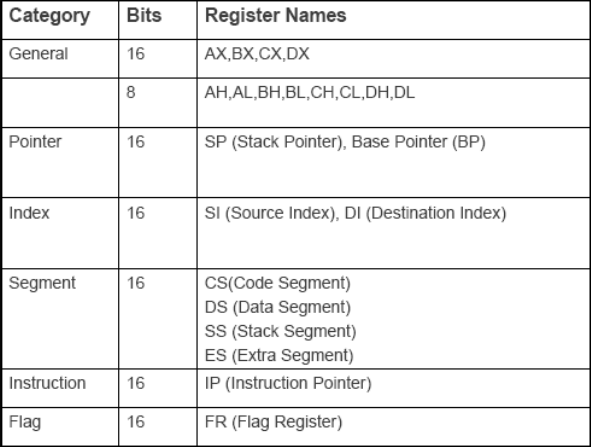The 8086 microprocessor accesses the
data in different ways such as from different registers, from memory
locations or from I/O ports are called its addressing modes. These
addressing modes are categorized according to the accessing method.
These are as follows.
1. Register Addressing Modes (Accessing data from registers)
2. Immediate Addressing Modes (Accessing immediate data and storing in the register as an operand )
2. Immediate Addressing Modes (Accessing immediate data and storing in the register as an operand )
3. Memory Addressing Modes (Accessing data from memory)
4. Direct Addressing Modes (Accessing direct data from I/O port)
5. Relative addressing modes (Related with some condition)
6. Implied or Implicit addressing mode (No operands)
Registers of 8086
General Purpose Registers
Pointer and Index Registers
1. Register Addressing Modes
In register addressing mode, most 8086
instructions can operate the general purpose register to set as an
operand to the instruction. This means a register is a source of an
operand as well as the register is only the destination of an operand
for an instruction.
MOV destination, source;
This instruction copies the data from the source location to the destination location. The 8-bit or 16 bit registers are certainly valid operands for this instruction. But both operands should be in the same size. Now let's see some 8086 MOV instructions:
This instruction copies the data from the source location to the destination location. The 8-bit or 16 bit registers are certainly valid operands for this instruction. But both operands should be in the same size. Now let's see some 8086 MOV instructions:
MOV AX, BX; Copies the 16 bit value from BX into AX,
Here the contents of AX is overlapping, but the contents of BX are not changed. (Both registers are in same size)
Example:
MOV DL, AL; Copies the value from AL into DLMOV SI, DX; Copies the value from DX into SI
MOV SP, BP; Copies the value from BP into SP
MOV CH, CL; Copies the value from CL into CH
2. Immediate Addressing Modes
In immediate addressing mode, the
hexadecimal number either 8-bit or 16-bit to be loaded immediately into
the memory locations or consecutive memory locations respectively. i.e
to load 8-bit immediate number into an 8-bit memory location or to load a
16-bit immediate number into two consecutive memory locations. Some
examples of that instructions.
Example:
MOV CX, 437BH; copies 16-bit hexadecimal number 437BH in the 16-bit CX register
MOV CL, 48H; Load the 8-bit immediate number 48H into the 8-bit CL register
MOV CL, 48H; Load the 8-bit immediate number 48H into the 8-bit CL register
3. Memory Addressing Mode:
The memory addressing modes are used to
specify the location of an operand as memory. To access data in memory,
the 8086 should be produce a 20-bit physical address. It does this by
adding a 16-bit value called the effective address (EA). The effective
address represents the displacement or offset of the desired operand
from the segment base. The data segment is most often used as a segment
base.
MOV AL, [BX]; ADD the contents of DS (One of four segment bases) with BX and result will shift in AL register.
MOV AL, [BP]; same as above
MOV AL, [BP]; same as above
The square bracket around the registers i.e. BX, BP are shorthand for
“the contents of that registers at a displacement from the segment base
of ."
4. Direct Addressing modes
This addressing mode is called direct because the displacement or
offset of the operand from the segment base is specified directly in the
instruction.
MOV CL, [437AH]; copy the contents of the memory
location , at a displacement of 437AH from the data segment base , into
the CL register.
MOV BX [437AH]; copies a word from memory into the BX register.
Note: each memory address represents a byte of storage, the word must
come from two memory locations. The byte at a displacement of 437AH from
the data segment base will be copied into BL. The contents of the next
higher address, displacement 437BH will be copied into the BH register.
The 8086 will automatically access the required number of bytes in
memory for a given instruction.
5. Relative addressing modes
This addressing mode is a relation base. The data is stored either in base pointer (BP) or in BX.
Example: MOV AX, [BP +1]JMP [BX + 1]
JNC START : if CF=0 or not carry then start the PC
6. Implicit or Implied addressing modes
In this addressing mode no operands are used to execute the instruction.Example: NOP : No operation
CLC : Clear carry flag to 0
START : Start execution




Sir what is the best microprocessor that is widely used in electronics world?
ReplyDeleteIntel is the premier chip maker for personal computers—companies such as Apple, Dell, HP, Samsung, Sony have product lines that depend on the processors that Intel produces. Intel's processors generally offer the best performance for all-around usage. This has been especially the case the last several years with the introduction and evolution of Intel's Core series product line. Currently, Intel's flagship consumer product line consists of mobile and desktop-grade Core i3, Core i5 and Core i7 processors. The biggest difference between these two generations amounts to a moderate improvement in all-around computing performance but a substantial improvement in integrated graphics performance.
Delete